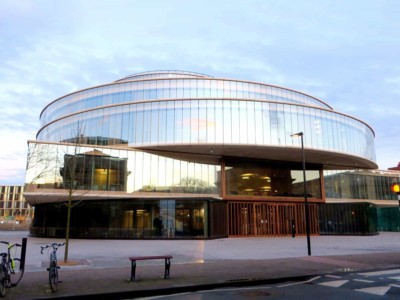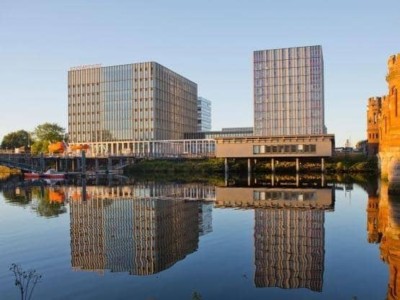This year’s Stirling Prize, awarded by the Royal Institute of British Architects to the most architecturally-significant building in the UK, will be awarded to entries from a shortlist of six, including two education institutions. With one from FE and one from HE, the choices and their citations tell us a lot about perceptions of the two from an uncommon perspective.
Next month the Blavatnik School of Government, a brushed steel and plate glass wedding cake of foreboding elegance takes on, among 4 others, City of Glasgow College’s new riverside campus. It’s a stocky construction of natural tones, by the side of the city’s Clyde river, once noted for its industry.
Their respective citations tell us so much about how post-16 education is viewed in the UK. Oxford University is bequeathed a building of “precise geometric form,” an oasis for its students in which “the spirit soars.” Never content with merely elevating the soul, Herzog & De Meuron, the firm which designed the Tate Modern in London and Beijing’s Birds Nest stadium, seek to “ensure that students engage at all levels,” with things like balconies and staircases. Seamlessly one of the HE sector’s leading lights develops a literal manifestation of learning and teaching quality – where better for the HE policy wonks of the future to learn?

This is the kind of building prized among HE institutions; imposing yet suave, civic in purpose but distant in design and, crucially, utterly unimaginable to most institutions in the country. The work is a status piece, an unmistakable symbol of Oxford’s place at the pinnacle of global affairs; political, academic, economic and artistic. Had almost any another institution built such a statement it would be regarded as vulgarity from a university which could only be hoping to ensnare student consumers with an ersatz vision of intellectual rigour.
Oxford’s new school of government implies the kind of largesse expected of top-tier universities, now more than ever under the new regime typified by the TEF. Institutions’ spending must align with the prestige accrued from marketing their intellectual product successfully: to be is to spend, to spend is to earn. While a modern university could scarcely contemplate hiring a firm like Herzog & de Meuron to design anything on campus without inviting protest from staff and students about the ways the money could alternatively be spent, Oxford and their ilk are obliged to indulge in this kind of conspicuous consumption.
It is worth asking where this money comes from. The Blavatnik School is named for its benefactor, Leonid Blavatnik, whose “timely investments,” in Russia’s aluminium and energy markets in the immediate post-Soviet period made him an exceptionally wealthy man. Were this school located on the banks of the Neva or the Moskva its name might evoke eye rolls as another symptom of Russia’s descent into plutocratic rule. In the UK it represents the proud ambition of an institution asserting itself on the global marketplace of knowledge.
But architecture for the impending élite should not draw attention from its credentials as a driver of social change. To that end City of Glasgow College makes the shortlist with a work so visionary it almost eludes the written word. Fortunately its two physical elements; the ‘teaching block’ and the ‘grand hall’ fulfil all two of the demands we place on our colleges today – a zen balance of branding and teaching. Past the security desk and swipe-access gates the teaching space “becomes a focus for public access,” a tonic for anxieties about how the elitism and exclusivity of even the idea of a ‘school of government’ might infect the wider system and prevent the masses from engaging.

Students can experience the “broadest possible range of learning” – a real benefit for those quietly considered depthless. While the students at Oxford nourish their souls amidst Swiss-designed opulence, City of Glasgow’s can meet what needs they have, whether eating in the cafe, or sitting down in the community space. The superficiality of the college learner means their needs do not extend to opaque walls – glass will do, and plenty of it here. A blessing really – were any walls or desks claimed by educators or learners they would likely disrupt the corporate balance, so carefully tuned between the two grand spaces.
Envisaging the college as a machine for learning is only more challenging when people become involved. Not inclined to embrace the corporate agenda set for most colleges which views their students as an output and their staff as an assembly line, people at all levels present problems for the corresponding architectural agenda.
Fortunately by blandly referring to ‘community’ and ‘shared spaces’ the shortlisters borrow from governments’ shared line – that if nobody from a college can realistically expect to reach the heights of someone from a top-end university, it makes sense to refer to the masses and their drudgery as something quaint, which institutions like Oxford could learn from if they weren’t so busy colonising the Earth with their knowledge.
Undoubtedly this is not a new phenomenon – ‘top’ universities have enjoyed refinement and excellence befitting their intellectual splendour for centuries while colleges are allowed only the most utilitarian practicalities. It isn’t even news that a board of experts in a field as oblivious to the human experience as architecture would reach so enthusiastically for platitudes utterly unconnected with the experience of learners. Perhaps this year’s award can breathe new life into the stolid critique of two of the UK’s most distant fields; people who build such vacuous spaces and the policy makers who give them the language to describe them as masterworks.
This article was amended at 5.50pm on July 26th to correct references regarding Leonard Blavatnik.













Brilliant, thank you for this thoughtful piece on the spaces we have come to take for granted. I do appreciate the HE/FE distinction, which is an extremely impotant one and one which most of us in HE never stop think about. Not to sound like another self-absorbed HE type though, it is also worth noting how much of the , “award winning”, “iconic” (!!) architecture in HE is confined to the departments that bring in “investment” (ie esp overseas-fees paying students). The contrast between the physical infrastructure (and outward appearance) of most business schools vs. let’s say humanities departments across… Read more »